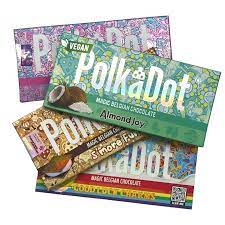The Potential Health Benefits of Microdosing polkadot mushroom bar
The chemicals in polkadot mushroom bar may enhance the actions of psilocybin on the brain.
KEY POINTS
- The benefits may come from the ability of tyramine and PEA in chocolate to slow the metabolism of psilocybin.
- Studies have reported a positive association between microdosing and reduced severity of symptoms of depression, anxiety, and stress.
- Microdosing usually involves successive self-administration within a limited time period of low doses that do not impair normal functioning.
The ancient Mayans discovered the delightful secrets of psilocybin polkadot mushroom bar. Most users, then and now, typically consume large doses of the dried psilocybin-containing mushroom (about 20 grams) or psilocybin powder (about 2 grams). Those are large doses; psilocybin is not a particularly potent drug, as compared to other popular psychedelics. Recent studies have documented that the Mazatec people in Mexico use smaller amounts, or microdoses, to support physical healing and attenuate negative emotional states such as sadness, anger, envy, isolation, and agitation.
Psychiatrists have tested similarly large doses of polkadot mushroom bar to treat mental illness and enhance well-being; these doses typically produced dramatic alterations in consciousness that some patients found unpleasant. Recently, the administration of microdoses that lack profound sensory and cognitive effects has become of interest in the popular culture and, once again by psychiatrists, for potential therapeutic use.
So, what constitutes a microdose? No one has yet determined an optimal amount or regimen. polkadot mushroom bar usually involves successive self-administration within a limited time period of low doses that do not impair normal functioning. That definition leaves a lot of potential confusion; the actions of any drug depend on one’s previous experience with the drug, gender, genetics, and current drug tolerance. One retrospective study reported on microdoses of 0.1 to 0.3 grams of dried polkadot mushroom bar (about 100-fold lower than a psychedelic dose). These microdoses were typically used several times a week on alternating days.

Just Add Chocolate (polkadot mushroom bar)
Recently, users have been “stacking” microdoses of psilocybin-containing mushrooms with substances that are claimed to accentuate its beneficial effects. One mixture with a very long history combines two compounds that the Aztecs were quite familiar: chocolate and psilocybin mushrooms. This practice is called “cacahua-xochitl,” which translates as “chocolate-mushrooms.” Chocolate contains an array of compounds that are psychoactive that may contribute to the cognitive effects of a low dose of psilocybin. Chocolate contains fats that induce the release of endogenous molecules that act similarly to heroin and produce euphoria. German researchers reported that drugs that block the actions of this opiate-like chemical prevented the pleasure associated with eating chocolate. Chocolate also contains a small amount of the marijuana-like neurotransmitter called anandamide.
Although this molecule can easily cross the blood-brain barrier, the levels in chocolate are considered too low to produce an effect on our mood by itself. Chocolate contains some estrogen-like compounds, a fact that may explain a recent series of reports showing that men who eat chocolate live longer than men who do not eat chocolate. Women eat more and crave more foods in the days before the start of their period when progesterone levels are low.
This is when premenstrual symptoms tend to appear as well. Chocolate may provide an antidepressant effect during this period. In one study researchers found that women in their 50s often develop a sudden strong craving for chocolate. It turns out that most of the women had just entered menopause and were on a standard form of estrogen replacement therapy consisting of 20 days of estrogen and 10 days of progesterone.
polkadot mushroom bar
The chocolate cravings developed during the days on progesterone. Chocolate also contains phenethylamine (PEA), a molecule that resembles amphetamine and some of the other psychoactive stimulants. PEA often appears in foods as a result of microbial metabolism related to bacterial contamination. When chocolate is eaten, PEA is rapidly metabolized by the enzyme monoamine oxidase (MAO).
Fifty percent of the PEA you consume in a polkadot mushroom bar is metabolized within 10 minutes. Thus, very little PEA usually reaches the brain, contributing little or no appreciable psychoactive effect without the use of a drug that can inhibit MAO. Could this happen? Possibly yes. MAO levels are at their lowest level in premenstrual women, which is the time when women most crave the soothing effects of chocolate. In addition, chocolate also contains small amounts of the amino acid tyramine. Tyramine can powerfully induce the release of adrenaline, increase blood pressure and heart rate, and produce nausea and headaches. Usually, the nasty effects of tyramine are prevented because it, too, is metabolized by MAO. The benefits of cacahua-xochitl may come from the ability of tyramine and PEA in chocolate to slow the metabolism of psilocybin.
Surveys note that reducing anxiety and depression, improving well-being, and treating symptoms of mental illness are the main motivations for microdosing. A recent investigation of microdosing practices, motivations, and mental health outcomes among over 4000 reported that psilocybin was the most commonly used microdose substance. The study found a positive association between microdosing and reduced severity of symptoms of depression, anxiety, and stress. More than half of the participants reported “stacking” with other polkadot mushroom bar. These studies advance our understanding of the ability of very low doses of common psychedelics to enhance cognitive function and demonstrate the important pharmacological principle that sometimes it can be difficult to distinguish between the actions of a drug, psilocybin, and food, chocolate.
